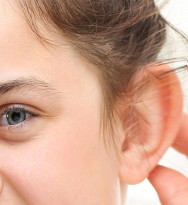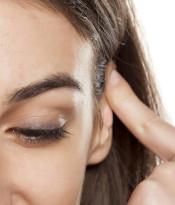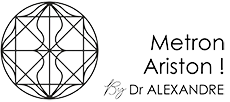

Otoplasty
(Prominent Ears Surgery)
The correction of prominent ears needs a surgical procedure called “otoplasty”, which the goal is to reshape the auricles, we think, are excessively too visible. The surgery is usually performed on the two auricles but could be done unilaterally.
An otoplasty corrects the auricle’s cartilaginous abnormalities which are the cause of the prominent aspect. Schematically, we can distinguish three types of abnormalities which are often, more or less, associated: Too open angle between the auricle and the skull, carrying out the so called “prominence” (valgus helix). Too large size of the conchal cartilage projecting forward the ear which improves the prominent aspect (concha hypertrophy). Failure into the normal cartilage reliefs folding which gives a too smooth, like “unpleated”, aspect to the ear (lack of anthelix plicature).
Surgery, definitively, corrects these abnormalities, by reshaping the ear cartilage, in order to obtain well-positioned, symmetrical ears also natural in size and aspect. So, prominent ears surgery also ends the mockeries and other unpleasant remarks which may have induced psychological difficulties or school problems. An otoplasty can be performed in an adult, in a teenager or, most of the time, in a 6-7 years old child, as soon as the child starts suffering of his/her ear aspect.
Before the operation
A meticulous clinical examination of the ears will be realized by the surgeon to determine the needed modifications. A usual pre-operative evaluation is done, following the prescriptions.
An anesthesiologist must be seen in consultation, at least 48 hours before surgery.
No medicine with aspirin in it must be taken for at least 10 days before surgery. Depending on the type of anesthesiology, you can be asked to fast (no food or beverage) for 6 hours before surgery.
For the boys, a short hair cut is suitable; for the girls, a pony tail is welcome. But in any patient, the hair must be carefully washed the day before surgery.
Hospital stay and type of anesthesia
Type of anesthesia:
- General anesthesia
- Local anesthesia with sedation given by intravenous drip (‘twilight’ anesthesia).
The choice must be made after you have thoroughly discussed all details with the surgeon and the anesthesiologist.
Hospital stay: The surgery can be done on an out-patient basis; you can leave hospital the same day of the surgery, after some hours of medical supervision. In some cases, it may be preferable to stay in hospital over the night; it means, you enter the hospital early morning, the day of surgery (or sometimes the day before) and leave the day after surgery.
The procedure
Techniques are adapted to each case, in order to get the best result. However, common surgical steps have to be used:
Skin incisions: Usually, there are inside the natural retro-auricular fold. But sometimes, some small complementary incisions may take place at the anterior side of the auricles, hidden inside natural folds.
Dissection: The skin will be then undermined to allow the cartilage to be reached.
Cartilage reshaping: The principle of this surgery is to create or improve the natural reliefs of the auricles by thinning and/or bending the cartilage framework, which may necessitate deep fine stitches. Sometimes, cartilage cutting or partial removing is indicated. Finally, the auricles are put back in a good position, in relation to the skull, and anchored by deep stitches.
Sutures: Usually, the skin is closed using absorbable stitches; if not, the stitches must be taken away within 10 days after surgery.
Dressing: It is done with elastic bandages around the head to keep the ears in a good position. Depending on the gravity of abnormalities to be corrected, the surgery may take half an hour to one hour and half, for both ears correction.
The surgical follow-up
Pains are usually moderate and if necessary, they can be treated using pain killers and anti-inflammatory drugs.
The dressing is removed within 2 to 5 days following surgery. It will be replaced by a lighter one for another few days.
During the early follow-up period, ecchymosis (bruises) and edema (swelling hiding the ear reliefs) can appear. This should not worry you; it will be transitory and not affecting the final result.
You must also avoid high cold temperature for at least 2 months after surgery, due to the frost-bite risk because of the transitory sensitiveness abatement.
Picture Gallery




The result
It will be appreciated within 1 to 2 months after surgery. It is the time needed for the edema to disappear, allowing the ear reliefs to be clearly seen. After this period of time, only the scar will be red and harden for another few months before toning down.
This surgical procedure will be most of the time efficient to correct auricle abnormalities and to give back natural well positioned, well oriented and well folded ears, also normal in size, symmetry and in general aspect.
In most of the cases, the result is definitively obtained. But sometimes, a slight recurrence of the prominent aspect of the ear may occur and indicate a slight secondary surgical correction.
A maintaining and protecting head-band will be used day and nights for 15 days and then for another few weeks, during night, only. During this period, you must avoid any sport activity.
Imperfect results
They can appear after a while, due to unexpected tissue retraction or unusual scarring process. Thus, you may sometimes notice light asymmetry between the two ears, small irregularities of the ear reliefs, too acute cartilage plicature, narrowing of the ear meatus or deep stitches feeling.
All these minor imperfections are discrete and not seen by others. Anyway, they can be corrected and refine the result under local anesthesia.
Possible complications
Even if conducted for aesthetical purposes, an otoplasty remains a true surgical procedure, entailing the same risks as any surgery. Firstly, concerning anesthesia, it may sometimes induce unpredictable reactions. However, dealing with a competent anesthesiologist, working in a real surgical environment, pushes down statistically the risks up to an almost insignificant level.
Modern techniques offer the patient optimal security, limiting risks as much as possible, however without totally eliminating them. Complications could always occur after an otoplasty, but this remains quite rare. Among, potential complications, we can quote:
- Post-operative bleeding: if it is more than just a blood fleck on the dressing, a secondary surgery may be necessary to stop the bleeding. However, the blood could induce a hematoma which could indicate its evacuation to protect the quality of the aesthetic result.
- An infection is rare due to the rigorous pre-operative asepsis rules. But in case an infection occurs, it needs quick treatment to avoid reaching the cartilage which can have severe consequences.
- Skin necrosis can exceptionally be observed. It is usually limited and localized at the anterior side of ear relief where the skin is very thin and the blood supply poor. The scarring just needs local dressings, whilst a small discrete scar may remain.
- Abnormal scars: an ear scar, of any kind, can always become hypertrophic or even more “a keloid scar” the treatment of which demands special treatment.
My Way …. “Metron Ariston”
Traditional otoplasty techniques have been reported to entail significant complications and a high recurrence rate, around 10%.
For this purpose, I use the G. JOST otoplasty procedure, an advanced elaborate technique that requires neither stitches nor blind cartilage scoring, avoiding any complications.
The Jost technique of cartilage splitting without stitches leads to excellent outcomes. The ear spontaneously assumes a natural shape after the cartilage scoring. No stitches are used to maintain the shape of the antihelical fold; therefore, stitch-related complications (i.e. palpation, extrusion, breaking) are avoided. The only stitches used are an absorbable suture to fill the dead space behind the concha and skin suture. That is why the specific technique is safe and reliable, with long-lasting outcomes.
.
This webpage aims to provide some information about the subject. Individual patient circumstances may differ, which might alter both the advice and course of therapy given to you by your doctor.
Source:
American Society of Plastic Surgeons, British Association of Plastic, Reconstructive and Aesthetic Surgeons, French Society of Plastic, Reconstructive and Aesthetic Surgery
